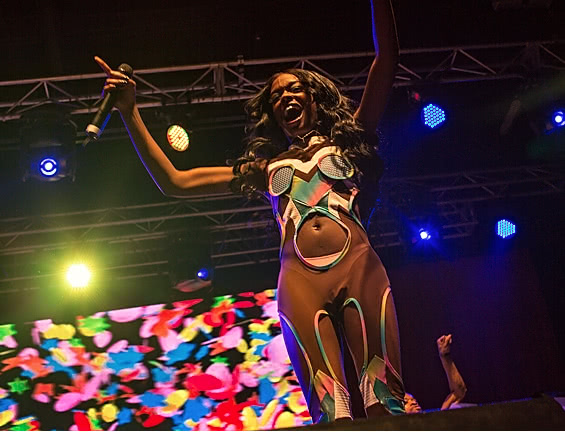One of the larger controversies in an otherwise pleasant (weather notwithstanding) Splendour In The Grass last year was the length of Azealia Banks’ set: to be precise, it went for a staggeringly brief 25 minutes.
Predictably, festival-goers were none too pleased, and Banks later tweeted (addressing herself to #AUSSIEKUNTS) that it was the fault of the management’s equipment, and added that she was “so, so sorry.”
With that in mind, her return trip to Australia should have been her opportunity to redeem herself. Instead, the Harlem native’s performance was barely longer than her Splendour fiasco, clocking in at just over 45 minutes.
Perhaps this isn’t surprising, considering her discography to date consists of only one mixtape, Fantasea, and her four-track EP 1991. There’s supposed to be an album in the works, but considering the clearly limited material she has to draw on, this prospect seems more and more mythological by the day.
Instead of album teasers, Banks drew on material from these two releases, and used her aggressive stage presence to captivate the crowd. It certainly helped that she was beautifully framed, in the opulent setting of Melbourne’s Palace Theatre.
Her first support, DJ Prequel, produced a traditionally exciting set of unpredictable remixes, more focused on flowing beats than catchy vocal hooks.
He transitioned smoothly into festival regular Nina Las Vegas’ turn on the stage – the two bounced around the table and took cute iPhone photos together before the Triple J host began her upbeat set.
Las Vegas has a seemingly instinctual knowledge of what will please her audience, and she was on fine form Thursday night; mixing hits from recent months (Flume’s ‘On Top’, Icona Pop’s ‘I Love It’) with the classics (Snoop Dogg’s ‘Drop It Like It’s Hot’, Destiny’s Child’s ‘Soldier’).
There was then a random 20 minute set from Banks’ DJ, before the femcee herself appeared.
Dressed in a cut-out brown, white, and blue bodysuit, with matching suspenders and high socks, Banks writhed around the stage in front of two similarly dressed dancers, her DJ, and an A/V screen showing hallucinogenic scenes in childishly bright colours.
Her unbelievably long, unbelievably shiny hair was as fluid as her dancing; Banks is titillation personified, in her video clips, in her actions, and in the flesh.
It was hard to distinguish any individual words in her rapping, but her appeal has always been in the way she matches her rapid-fire syllables with punchy inflection rather than any particular message.
Songs dripping in bravado, like ‘Jumanji’ and the self-described Banks anthem ‘Liquorice’, were even more intoxicating live than on recording, fuelled by the troublemaker’s persuasive swagger.
She finished with a high-energy rendition of the song that made her name, ‘212’, as her ecstatic audience shouted the profanity-heavy lyrics back at her. This melted into a feisty version of the Prodigy’s ‘Firestarter’. And then she disappeared again into the wings, without so much as an encore – much to the disappointment of the crowd imploring her to return.
Azealia Banks’ music, and indeed her entire persona, is based around disrespect.
She is just as famous for her twitter beefs with electronic music artists (Baauer of ‘Harlem Shake’ fame), offensive language (she called Perez Hilton a “faggot”), and dissing other rappers (Kreayshawn, Iggy Azalea, Nicki Minaj) as she is her actual music.
But to extend that disrespect to her fans – the people that invest time, energy, and money into seeing her perform – takes her to the next level of unprofessionalism.
She was entertaining enough, but in such a short show, every one of those 45 minutes would have to be spectacular for the crowd to get their $70 worth, and unfortunately that wasn’t the case.
But maybe it’s our fault. You know the old saying; fool us once, shame on you. Fool us twice, shame on us.
This writer, for one, won’t be giving Azealia Banks a third opportunity to prove herself.




































